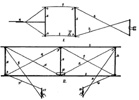

 |
 |
The Wright Brothers' 1900 Kite and Glider ExperimentsBy 1899, the Wright brothers had become seriously interested in the problem of human flight. After they exhausted the references locally available to them, they wrote to the Smithsonian Institution in Washington, D.C., for further information. When they read the works of others, particularly Lilienthal, Octave Chanute, and Samuel Pierpont Langley, they realized the one factor that had prevented others from achieving successful flight was the pilot's lack of ability to balance and control the craft once it was airborne. They felt the other difficulties of propulsion and determining the most efficient wing shape were minor in comparison, or had already been solved. |
In
May 1900, when Wilbur was 33 and Orville 29, Wilbur wrote to Octave Chanute
and introduced Orville and himself. At 68, Chanute was a well-known
engineer and leading authority on aviation. He had conducted his
own flight experiments and documented the efforts of the many people who
had attempted to build flying machines. In his letter to Chanute, Wilbur
At the time, most inventors were designing flying machines that were inherently stable. These craft would maintain a straight and level course with little maneuvering by the pilot. In contrast, Wilbur believed that the pilot had to have a means of controlling and balancing the motion of an aircraft in every axis. To solve the lateral control issue, he developed the concept of "wing-warping" This control system worked by twisting the wings in opposite directions, which increased the air pressure on one wing while decreasing it on the other. The resulting effect lifted one wing and lowered the other.

Drawing of the Wrights' Glider.
In July 1899, Wilbur built a kite to test a wing-warping control system. When he tested the kite, he was able to make it climb, dive, and roll by manipulating the kite strings. The Wrights were ready to move on to the next step.
In
1900, they methodically began designing their first full-size, man-carrying
aircraft, which they originally intended to use as a kite
When their design was nearly complete, they wrote to the U.S. Weather Bureau for help in finding the best place to build and test their invention. Based on the information they received, they decided Kitty Hawk, a wind-blown village on the Outer Banks of North Carolina, offered them the most suitable wind conditions and plentiful sand dunes to cushion their landings.
Wilbur departed Dayton and arrived at Kitty Hawk on September 12, 1900. Initially he stayed with William Tate; his wife, the local postmistress; and their three daughters. He began assembling their kite, a biplane, with a 17-foot (5.2-meter) wingspan. This configuration was chosen for its great strength and was based on data Lilienthal had provided. Orville joined him two weeks later, bringing a tent and more supplies.
The brothers began their test flights during the first week in October. Their kite had a wing area of 165 square feet (15 square meters) and a forward elevator for pitch control and some protection in the event of a crash. The first flights of the tethered kite were made without a pilot on board. The aircraft did not develop as much lift as they had expected and the flights were disappointing. On October 10, the wind caught the aircraft while on the ground, crashed it 20 feet (6 meters) away, and damaged it in several places. It was repaired and design adjustments were made. The brothers continued their test flights flying the kite empty or loaded with 25 or 50 pounds (11 or 22 kilograms) of chain on board.
On October 17, they flew their aircraft as a tethered kite with 10-year-old Tom Tate, William's nephew, on board. Again, the results were still less than expected, and they concluded that they would have to try free glides into the wind to generate enough lift to fly the kite. The next day, Wilbur climbed on board and flew—gliding without the constraints of a tether—as much as 300 to 400 feet (91 to 121 meters) for up to 15 seconds. He found these flights thoroughly exhilarating—he was flying!
During the next week, the wind was too light for manned glides, and the brothers broke camp for the winter on October 23. They returned to Dayton with plans to come again the next year with a larger glider. They abandoned their 1900 glider in the sand. Bill Tate's wife cut the sateen cloth from the kite, washed it, and fashioned it into dresses for her daughters.
|
Educational Organization |
Standard Designation (where applicable) |
Content of Standard |
|
International Technology Education Association |
Standard 10 |
Students will develop an understanding of trouble shooting and experimentation in problem solving. |
|
International Technology Education Association |
Standard 9 |
Students will develop an understanding of engineering design. |
|
National Science Education Standards |
Content Standard A |
The role of communication in scientific inquiry. |